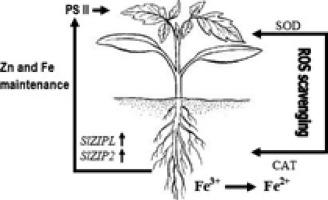当前位置:
X-MOL 学术
›
Sci. Hortic.
›
论文详情
Our official English website, www.x-mol.net, welcomes your
feedback! (Note: you will need to create a separate account there.)
Regulation of Zn uptake and redox status confers Zn deficiency tolerance in tomato
Scientia Horticulturae ( IF 3.9 ) Pub Date : 2020-11-01 , DOI: 10.1016/j.scienta.2020.109624 Mst Salma Akther , Urmi Das , Sharaban Tahura , Sadia Akter Prity , Monirul Islam , Ahmad Humayan Kabir
Scientia Horticulturae ( IF 3.9 ) Pub Date : 2020-11-01 , DOI: 10.1016/j.scienta.2020.109624 Mst Salma Akther , Urmi Das , Sharaban Tahura , Sadia Akter Prity , Monirul Islam , Ahmad Humayan Kabir

|
Abstract Zinc (Zn) is a well-known nutritional problem affecting plant growth and development. Due to Zn deficiency in the soil, tomato plants exhibit yield loss. This study was conducted on two contrasting tomatoes genotypes (Marglobe and Ratan) subjected to Zn deficiency to unveil the mechanistic foundation of Zn-deficiency tolerance in this vegetable. We found that Zn deficiency adversely affected plant biomass and photosynthesis parameters (chlorophyll score, quantum efficiency of photosystem, photosynthesis performance index) in Zn-deficiency sensitive Ratan. Furthermore, Zn-shortage showed increased electrolyte leakage, cell death %, and hydrogen peroxide concentration in Ratan (Zn-deficiency sensitive), which was not evident in Marglobe (Zn-deficiency tolerant). The metal analysis showed no significant decrease of Zn and Fe in Marglobe; however, Ratan exhibited a significant decline in Zn and Fe in both root and shoot subjected to Zn shortage. It suggests that maintaining Zn status is one of the adaptive mechanisms that Marglobe exhibits subjected to Zn shortage. This was further supported by the constitutive expression of SlIRT1 (Fe-regulated transporter) along with increased ferric reductase activity in addition to the upregulation of ZIP (Irt-like proteins) transporters (SlZIPL and SlZIP2) in roots of Marglobe. It also implies that Zn acquisition was tightly regulated and may also be dependent on Fe homeostasis in Marglobe. Together with Zn status, the elevated CAT (catalase) and SOD (superoxide dismutase) activities were actively associated with Zn-deficiency induced ROS (reactive oxygen species) regulation in Marglobe. Finally, auxin inhibitor resulted in a marked interruption in photosynthesis, growth, and ROS scavenging, indicating its crucial involvement in the adaptive mechanisms that Marglobe showed under Zn deficiency. This study uncovers the mechanistic strategies that confer tolerance to Zn shortage in tomato plants.
中文翻译:

锌吸收和氧化还原状态的调节赋予番茄缺锌耐受性
摘要 锌(Zn)是众所周知的影响植物生长发育的营养问题。由于土壤中缺锌,番茄植株产量下降。本研究针对两种对比鲜明的缺锌番茄基因型(Marglobe 和 Ratan)进行,以揭示这种蔬菜缺锌耐受性的机制基础。我们发现缺锌会对缺锌敏感的 Ratan 中的植物生物量和光合作用参数(叶绿素评分、光系统量子效率、光合作用性能指数)产生不利影响。此外,在 Ratan(缺锌敏感)中,缺锌显示电解质泄漏、细胞死亡百分比和过氧化氢浓度增加,这在 Marglobe(缺锌耐受)中不明显。金属分析表明 Marglobe 中 Zn 和 Fe 没有显着减少;然而,在缺锌的情况下,Ratan 的根和地上部的锌和铁含量显着下降。这表明维持锌的状态是 Marglobe 在锌短缺的情况下表现出的适应机制之一。除了 Marglobe 根中 ZIP(Irt 样蛋白)转运蛋白(SlZIPL 和 SlZIP2)的上调外,SlIRT1(Fe 调节的转运蛋白)的组成型表达以及铁还原酶活性的增加进一步支持了这一点。这也意味着 Zn 的获取受到严格监管,也可能取决于 Marglobe 中的 Fe 稳态。连同锌状态,升高的 CAT(过氧化氢酶)和 SOD(超氧化物歧化酶)活性与 Marglobe 中缺锌诱导的 ROS(活性氧)调节密切相关。最后,生长素抑制剂导致光合作用、生长和 ROS 清除的显着中断,表明其在 Marglobe 在缺锌条件下表现出的适应性机制中具有重要作用。这项研究揭示了赋予番茄植物锌缺乏耐受性的机制策略。
更新日期:2020-11-01
中文翻译:

锌吸收和氧化还原状态的调节赋予番茄缺锌耐受性
摘要 锌(Zn)是众所周知的影响植物生长发育的营养问题。由于土壤中缺锌,番茄植株产量下降。本研究针对两种对比鲜明的缺锌番茄基因型(Marglobe 和 Ratan)进行,以揭示这种蔬菜缺锌耐受性的机制基础。我们发现缺锌会对缺锌敏感的 Ratan 中的植物生物量和光合作用参数(叶绿素评分、光系统量子效率、光合作用性能指数)产生不利影响。此外,在 Ratan(缺锌敏感)中,缺锌显示电解质泄漏、细胞死亡百分比和过氧化氢浓度增加,这在 Marglobe(缺锌耐受)中不明显。金属分析表明 Marglobe 中 Zn 和 Fe 没有显着减少;然而,在缺锌的情况下,Ratan 的根和地上部的锌和铁含量显着下降。这表明维持锌的状态是 Marglobe 在锌短缺的情况下表现出的适应机制之一。除了 Marglobe 根中 ZIP(Irt 样蛋白)转运蛋白(SlZIPL 和 SlZIP2)的上调外,SlIRT1(Fe 调节的转运蛋白)的组成型表达以及铁还原酶活性的增加进一步支持了这一点。这也意味着 Zn 的获取受到严格监管,也可能取决于 Marglobe 中的 Fe 稳态。连同锌状态,升高的 CAT(过氧化氢酶)和 SOD(超氧化物歧化酶)活性与 Marglobe 中缺锌诱导的 ROS(活性氧)调节密切相关。最后,生长素抑制剂导致光合作用、生长和 ROS 清除的显着中断,表明其在 Marglobe 在缺锌条件下表现出的适应性机制中具有重要作用。这项研究揭示了赋予番茄植物锌缺乏耐受性的机制策略。










































 京公网安备 11010802027423号
京公网安备 11010802027423号